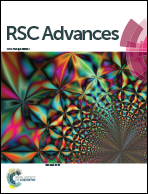Templated electrochemical synthesis of conducting polymer nanowires from corresponding monomer nanoemulsions prepared by tandem acoustic emulsification†
Abstract
A new approach to the preparation of solid conducting polymer nanowires is proposed, involving templated electrochemical polymerization of a corresponding monomer nanoemulsion formed by tandem acoustic emulsification.


 Please wait while we load your content...
Please wait while we load your content...